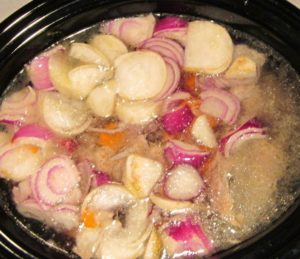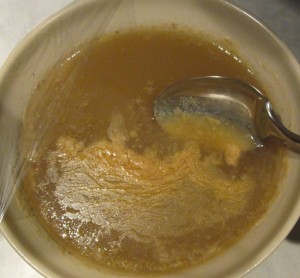It’s not a renaissance for everyone but, personally, I fall into the group that didn’t grow up with soup stock as a staple. It seems either you grew up with soup stock and wouldn’t dream of tossing out bones without boiling the life out of them, or soup stock is just something you saw in a recipe once. The truth is, if you’re not making soup stock every chance you get you’re missing out on a wonderfully nutrient dense food source that is practically free!
 |
| Cooking Soup Stock |
Boiling bones produces gelatin rich in the amino acids arginine and glycine. Along with these amino acids, gelatin is water-absorbing which aids in digestion and has been used successfully to treat intestinal disorders such as Crohn’s and IBS. Allowing the bones to sit in water with a little vinegar, before boiling, leaches calcium, magnesium, phosphorus, silicon, sulphur and trace minerals from the bones right into the stock. Soup stock is a powerhouse of nutrition!
 |
| Skimming the Fat |
For our first try at making soup stock we followed the recipe below taken directly from Sally Fallon’s book, Nourishing Traditions: The Cookbook that Challenges Politically Correct Nutrition and the Diet Dictocrats We didn’t have the chicken’s feet, but we did have the other chicken parts. We followed the directions carefully and boiled the stock a full 24 hours.
We didn’t have the chicken’s feet, but we did have the other chicken parts. We followed the directions carefully and boiled the stock a full 24 hours.
Chicken Stock
1 whole free-range chicken or 2 to 3 pounds of bony chicken parts, such as necks, backs, breastbones and wings*
gizzards from one chicken (optional)
2-4 chicken feet (optional)
4 quarts cold filtered water
2 tablespoons vinegar
1 large onion, coarsely chopped
2 carrots, peeled and coarsely chopped
3 celery stalks, coarsely chopped
1 bunch parsley
gizzards from one chicken (optional)
2-4 chicken feet (optional)
4 quarts cold filtered water
2 tablespoons vinegar
1 large onion, coarsely chopped
2 carrots, peeled and coarsely chopped
3 celery stalks, coarsely chopped
1 bunch parsley
*Note: Farm-raised, free-range chickens give the best results. Many battery-raised chickens will not produce stock that gels.
If you are using a whole chicken, cut off the wings and remove the neck, fat glands and the gizzards from the cavity. Cut chicken parts into several pieces. (If you are using a whole chicken, remove the neck and wings and cut them into several pieces.) Place chicken or chicken pieces in a large stainless steel pot with water, vinegar and all vegetables except parsley. Let stand 30 minutes to 1 hour. Bring to a boil, and remove scum that rises to the top. Reduce heat, cover and simmer for 6 to 24 hours. The longer you cook the stock, the richer and more flavorful it will be. About 10 minutes before finishing the stock, add parsley. This will impart additional mineral ions to the broth.
Remove whole chicken or pieces with a slotted spoon. If you are using a whole chicken, let cool and remove chicken meat from the carcass. Reserve for other uses, such as chicken salads, enchiladas, sandwiches or curries. Strain the stock into a large bowl and reserve in your refrigerator until the fat rises to the top and congeals. Skim off this fat and reserve the stock in covered containers in your refrigerator or freezer.
I particularly like the feeling of using the whole animal and not throwing anything away. It’s a wonderful way to honor the sacrifice the animal made for us. Something not many of us stop to consider, but we should.
 |
| Soup Stock for Frig & Freezer |
We’ve had some wonderful homemade soup from the stock and I’m looking forward to enjoying a cupful of stock straight away as a hot drink. Another immeasurable benefit is the wonderful aroma that will fill your kitchen as the stock slowly simmers. I can’t wait to make some more!
Written by Peter Wright
Latest posts by Peter Wright, NTP, CGP (see all)
- Dehydrated Broth – Making It Easy to Drink Broth Every Day! - March 11, 2017
- Lose 10 lbs DURING the Holidays - November 19, 2016
- Finding Good Oils - February 7, 2016


No comments yet.